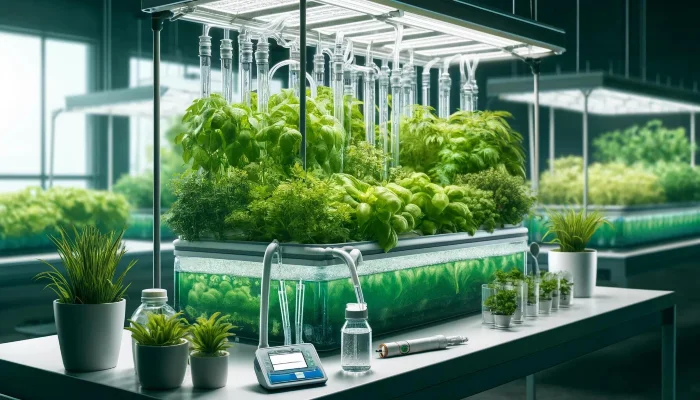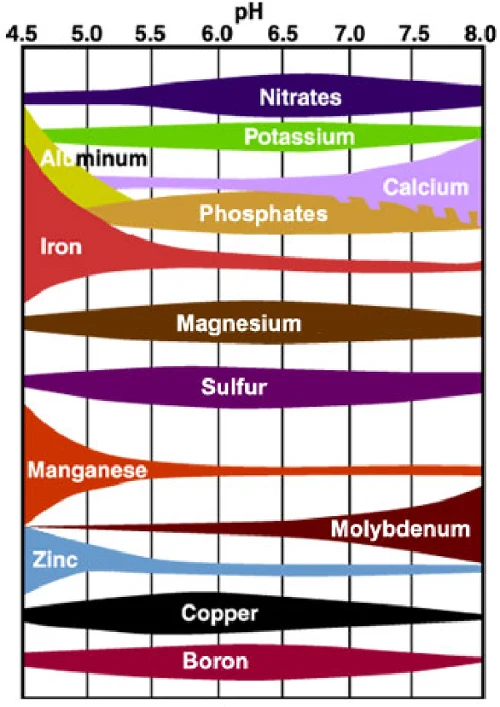Jumping into the world of hydroponics? Don’t overlook the pH level of your nutrient solution. Striking the right balance can be the difference between thriving plants and a disappointing grow. You can use baking soda as a simple, safe, and effective way to adjust pH levels in your hydroponic setup.
Why Does pH Matter in Hydroponics?
pH, short for “potential of hydrogen,” isn’t just a number on a scale; it’s the determining factor to successful hydroponic gardening. This scale, measuring the acidity or alkalinity of a solution, plays a pivotal role in the proper pH levels and productivity of your plants. In hydroponics, the stakes are even higher, as plants are directly dependent on water for their nutrient intake. No soil pH here to make up for missing nutrients!
The ideal pH for most hydroponic systems is between 5.5 and 6.5 because it affects the solubility and availability of essential nutrients. For instance, crucial nutrients like nitrogen, phosphorus, and potassium are best absorbed by plants when the pH of the nutrient solution is within this optimal range. When the pH strays from these values—whether too high or too low—it can trigger a host of problems, including nutrient deficiencies.
A high pH, or alkaline condition, can cause certain nutrients to become less soluble (meaning the plant can’t break it down), leading to nutrient lockout where plants cannot access them. This results in stunted growth, yellowing of leaves, and a drop in productivity.
On the other hand, an overly acidic environment can lead to toxic levels of certain elements, such as manganese, iron, and aluminum, which can be detrimental to plant health. Toxicity will look like brown spots on leaves, stunted root growth, interveinal chlorosis (yellowing between the veins of the leaves), and a poor yield. It’s serious!
Managing pH levels in hydroponics is all about consistency. Fluctuations in pH can stress plants, leading to weak defenses against diseases and pests. Monitoring and adjustment is a necessary, and important, aspect of hydroponic management. Tools like electronic pH meters or pH test strips can help maintain this balance.
Maintaining the correct pH not only helps in nutrient uptake but also supports the beneficial microorganisms in the hydroponic solution. These microorganisms play a significant role in breaking down organic matter and stabilizing nutrients, which helps plant growth.
As if that wasn’t enough, the system’s pH level also ensures that the electrical conductivity (EC) of the solution, which measures the total soluble salts in the water, remains optimal. This is essential as EC levels are closely tied to the nutrient concentration, influencing how well your different plants feed.
Managing the pH in hydroponics isn’t just a routine task—it’s a job that guarantees higher yields.
How about a quick review just to drive this point home?
What Happens to a Plant When pH is Too High (Alkaline):
- Nutrient Lockout: Essential nutrients like iron, manganese, boron, copper, and zinc become less available, leading to deficiencies.
- Reduced Chlorophyll Production: A lack of available iron and manganese can lead to chlorosis, where leaves turn yellow due to insufficient chlorophyll.
- Stunted Growth: Poor nutrient uptake affects overall growth and development, leading to shorter, weaker plants.
- Root System Stress: High pH can damage the root system, reducing its ability to absorb water and nutrients effectively.
What Happens to a Plant When pH is Too Low (Acidic):
- Toxic Element Uptake: Increased solubility of elements like aluminum and manganese can lead to toxicity, causing root and leaf damage.
- Nutrient Imbalances: Excessive uptake of certain nutrients can inhibit the absorption of others, disrupting the nutritional balance.
- Root Burn: Highly acidic conditions can cause root burn, physically damaging the root structure and impairing plant health.
- Increased Vulnerability to Diseases: Acidic conditions can foster the growth of certain pathogens, increasing the likelihood of disease.
Baking Soda in Hydroponics
Baking soda (sodium bicarbonate) acts as a pH buffer, helping to stabilize pH levels in your hydroponic system. So, all those memes about how helpful baking soda is around your house, are true! Baking soda mildly raises pH when added to your hydroponic solution, helping the plants without overpowering them. Basically, it gets the job done without risking too much of an increase in levels at once.
Step-by-Step Guide to Using Baking Soda in Hydroponics
Adjusting the pH of your hydroponic system with baking soda is straightforward. Here’s how to do it correctly:
- Test the Current pH: Before adding anything, test the pH of your nutrient solution using pH test strips or an electronic pH meter.
- Calculate the Amount: Generally, you’ll need about 1 teaspoon of baking soda per gallon of water to mildly adjust the pH. Start small as it can vary.
- Mix Well: Dissolve the baking soda in a small amount of water and add it to your hydroponic reservoir.
- Re-test and Adjust: After mixing, wait an hour, re-test the pH, and adjust if necessary. You’ll need to adjust gradually to avoid shocking your plants.
Monitoring and Adjusting pH in Hydroponics Using Baking Soda
Remember when I said that maintaining the proper pH level in your hydroponic system is a job? Monitoring and adjusting regularly is the entire job description!
Baking soda works great, and it’s natural, but you must use it wisely to avoid causing imbalances in your hydroponic system.
Here are some top things to watch out for and the most common ways to compensate for them when using baking soda to adjust pH levels:
Top Things to Watch Out For:
- Overcorrection: Adding too much baking soda can rapidly increase the pH, potentially leading to alkalinity. This can lock out certain nutrients, preventing their absorption by plants.
- Sodium Accumulation: Regular use of baking soda adds sodium to the water, which can build up over time and potentially harm plant health.
- pH Rebound: Sometimes, the pH may initially adjust to the desired level, but then drift back. This rebound effect requires careful monitoring and adjustment.
How to Compensate for These Issues:
- Incremental Adjustments: Always adjust pH gradually. Add small amounts of baking soda, then wait and test the pH again before adding more. This approach helps prevent overcorrection.
- Regular Water Changes: To combat the build-up of sodium and other unwanted residuals from baking soda, regularly change your system’s water. This will maintain a balanced nutrient and pH level.
- Consistent Monitoring: Use a reliable pH meter to check the pH levels regularly—at least once every two days. Consistent monitoring allows you to catch and rectify pH drift or rebound before it becomes a problem.
- Alternate pH Adjusters: If you find that you’re using baking soda too frequently, consider alternating with other pH adjusting agents like potassium bicarbonate, which does not contribute to sodium accumulation. Variety can help maintain a more balanced ionic composition in your hydroponic solution for good pH values.
Alternative Methods to Adjust pH in Hydroponics
While baking soda is excellent for minor adjustments, other materials or commercial products might be necessary for bigger shifts. The following are the best solutions as baking soda alternatives:
- Potassium Carbonate: Ideal for raising pH without adding sodium to the system, making it a preferred choice for maintaining optimal pH levels in hydroponic solutions.
- Citric Acid: Used to lower pH quickly; this organic compound is effective but requires careful handling to avoid rapid, drastic pH changes.
- Phosphoric Acid: Commonly used to decrease pH; it provides the added benefit of contributing phosphorus, a crucial nutrient in hydroponic systems.
- Sulfuric Acid: Effective for lowering pH and controlling alkalinity; suitable for larger systems due to its potency and need for precise application.
- Dolomite Lime: Slow acting compared to other methods, best suited for gradual pH adjustments and adding magnesium and calcium to the nutrient solution.
- Vinegar (Acetic Acid): Who doesn’t have vinegar on hand!? It can lower pH, but is typically less stable and more suitable for small-scale or temporary adjustments.
Each of these alternatives offers specific benefits and drawbacks, so choosing the right pH adjuster depends on your specific hydroponic setup and plant requirements.
Common Issues and Troubleshooting in Hydroponics pH Management
Maintaining the correct pH in hydroponics can be frustrating. Here are some common issues and their solutions:
- pH Fluctuations: Frequent changes in pH can stress plants, leading to poor growth and lower yields. Use a reliable electronic pH meter to monitor the pH of your nutrient solution regularly, allowing for timely adjustments.
- Nutrient Lockout: Occurs when the pH is not within the optimal range, causing essential nutrients like calcium, magnesium, and potassium to become unavailable to plants. This can result in visible symptoms like leaf discoloration and stunted growth. To address this, adjust the pH gradually to the desired level using pH up or down solutions like baking soda, citric acid or potassium carbonate.
- Sodium Buildup from Baking Soda: If you’re not careful, too much baking soda for pH adjustment can lead to excessive sodium accumulation, which can be toxic to plants. To prevent this, alternate with other pH adjusters that do not contain sodium, don’t go overboard with the baking soda, and perform regular system flushes with RO water or distilled water. Tap water is not a good idea here.
- Calibration Errors: Inaccurate pH readings from uncalibrated pH meters can lead to inappropriate adjustments. Check that your electronic pH meters are calibrated according to the manufacturer’s instructions, and use pH test strips as a backup for verification.
Like I’ve said twice before, monitoring pH levels is an important job.
FAQs for Managing pH in Hydroponics
How often should I check my hydroponic system’s pH?
Check the pH every two to three days, or daily if adjusting pH or experiencing fluctuations, to ensure stability and optimal nutrient uptake.
Can I use baking soda in any hydroponic system?
Yes, but use the recommended amount of about one teaspoon per gallon to avoid overcorrection and potential sodium buildup. Consider alternatives like potassium carbonate for sodium-sensitive systems.
What is the best way to correct a significant pH imbalance in my hydroponic system?
Make gradual adjustments using pH buffers such as potassium silicate to raise pH or phosphoric acid to lower it, testing the pH after each application until the desired range is reached.
More To Discover
- Water Batteries: The Safe, Affordable, and Eco-Friendly Energy of the Future That Won’t Explode
- Wind Fence Innovates Clean Energy in Urban Landscapes
- UK Launches Investigation into Dove Parent Unilever’s Green Claims
- The Alarming Disappearance of Amphibians: A Global Cry for Help That Will Deeply Affect Us If We Ignore It
Is it necessary to adjust pH if I’m using distilled water in my hydroponic system?
Yes, test the pH of your hydroponic nutrient solution after adding nutrients as even distilled water can shift from neutral due to nutrient solutions, ensuring it remains within the optimal 5.5 to 6.5 range.
To wrap up this article, I’ll say two things; baking soda is awesome and managing and maintaining a hydroponic system’s optimum pH balance is a job.























